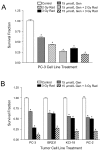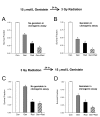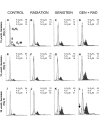Genistein inhibits radiation-induced activation of NF-kappaB in prostate cancer cells promoting apoptosis and G2/M cell cycle arrest
- PMID: 16640785
- PMCID: PMC1464148
- DOI: 10.1186/1471-2407-6-107
Genistein inhibits radiation-induced activation of NF-kappaB in prostate cancer cells promoting apoptosis and G2/M cell cycle arrest
Abstract
Background: New cancer therapeutic strategies must be investigated that enhance prostate cancer treatment while minimizing associated toxicities. We have previously shown that genistein, the major isoflavone found in soy, enhanced prostate cancer radiotherapy in vitro and in vivo. In this study, we investigated the cellular and molecular interaction between genistein and radiation using PC-3 human prostate cancer cells.
Methods: Tumor cell survival and progression was determined by clonogenic analysis, flow cytometry, EMSA analysis of NF-kappaB, and western blot analysis of cyclin B1, p21WAF1/Cip1, and cleaved PARP protein.
Results: Genistein combined with radiation caused greater inhibition in PC-3 colony formation compared to genistein or radiation alone. Treatment sequence of genistein followed by radiation and continuous exposure to genistein showed optimal effect. Cell cycle analysis demonstrated a significant dose- and time-dependent G2/M arrest induced by genistein and radiation that correlated with increased p21WAF1/Cip1 and decreased cyclin B1 expression. NF-kappaB activity was significantly decreased by genistein, yet increased by radiation. Radiation-induced activation of NF-kappaB activity was strongly inhibited by genistein pre-treatment. A significant and striking increase in cleaved PARP protein was measured following combined genistein and radiation treatment, indicating increased apoptosis.
Conclusion: A mechanism of increased cell death by genistein and radiation is proposed to occur via inhibition of NF-kappaB, leading to altered expression of regulatory cell cycle proteins such as cyclin B and/or p21WAF1/Cip1, thus promoting G2/M arrest and increased radiosensitivity. These findings support the important and novel strategy of combining genistein with radiation for the treatment of prostate cancer.
Figures





Similar articles
-
p53-independent induction of p21 (WAF1/CIP1), reduction of cyclin B1 and G2/M arrest by the isoflavone genistein in human prostate carcinoma cells.Jpn J Cancer Res. 2000 Feb;91(2):164-73. doi: 10.1111/j.1349-7006.2000.tb00928.x. Jpn J Cancer Res. 2000. PMID: 10761703 Free PMC article.
-
Identification of both Myt-1 and Wee-1 as necessary mediators of the p21-independent inactivation of the cdc-2/cyclin B1 complex and growth inhibition of TRAMP cancer cells by genistein.Prostate. 2006 Oct 1;66(14):1542-55. doi: 10.1002/pros.20495. Prostate. 2006. PMID: 16924665
-
Genistein-induced upregulation of p21WAF1, downregulation of cyclin B, and induction of apoptosis in prostate cancer cells.Nutr Cancer. 1998;32(3):123-31. doi: 10.1080/01635589809514730. Nutr Cancer. 1998. PMID: 10050261
-
Multi-targeted therapy of cancer by genistein.Cancer Lett. 2008 Oct 8;269(2):226-42. doi: 10.1016/j.canlet.2008.03.052. Epub 2008 May 19. Cancer Lett. 2008. PMID: 18492603 Free PMC article. Review.
-
Genistein Implications in Radiotherapy: Kill Two Birds with One Stone.Molecules. 2025 Jan 5;30(1):188. doi: 10.3390/molecules30010188. Molecules. 2025. PMID: 39795243 Free PMC article. Review.
Cited by
-
Role of phytoestrogens in cancer therapy.Planta Med. 2010 Aug;76(11):1132-42. doi: 10.1055/s-0030-1250074. Epub 2010 Jul 1. Planta Med. 2010. PMID: 20597043 Free PMC article. Review.
-
Pharmacokinetic and Metabolomic Studies with BIO 300, a Nanosuspension of Genistein, in a Nonhuman Primate Model.Int J Mol Sci. 2019 Mar 12;20(5):1231. doi: 10.3390/ijms20051231. Int J Mol Sci. 2019. PMID: 30870965 Free PMC article.
-
Targeting prostate cancer based on signal transduction and cell cycle pathways.Cell Cycle. 2008 Jun 15;7(12):1745-62. doi: 10.4161/cc.7.12.6166. Epub 2008 Jun 16. Cell Cycle. 2008. PMID: 18594202 Free PMC article. Review.
-
Targeting inflammatory pathways for tumor radiosensitization.Biochem Pharmacol. 2010 Dec 15;80(12):1904-14. doi: 10.1016/j.bcp.2010.06.039. Epub 2010 Jun 30. Biochem Pharmacol. 2010. PMID: 20599771 Free PMC article. Review.
-
Protective and Restorative Effects of Nutrients and Phytochemicals.Open Biochem J. 2018 Apr 17;12:46-64. doi: 10.2174/1874091X01812010046. eCollection 2018. Open Biochem J. 2018. PMID: 29760813 Free PMC article. Review.
References
-
- Jemal A, Siegel R, Ward E, Murray T, Xu J, Smigal C, Thun MJ. Cancer Statistics, 2006. CA Cancer J Clin. 2006;56:106–130. - PubMed
-
- Zietman AL, Shipley WU, Willett CG. Residual disease after radical surgery or radiation therapy for prostate cancer. Cancer. 1993;71:959–969. - PubMed
-
- Forman JD. Neutron radiation for prostate cancer. Prostate J. 1999;1:8–14. doi: 10.1046/j.1525-1411.1999.00003.x. - DOI
-
- Norman HA, Butrum RR, Feldman E, Heber D, Nixon D, Picciano MF, Rivlin R, Simopoulos A, Wargovich MJ, Weisburger EK, Zeisel SH. The role of dietary supplements during cancer therapy. J Nutr. 2003;133:3794S–3799S. - PubMed
-
- Norman HA, Go VL, Butrum RR. Review of the international research conference on food, nutrition, and cancer, 2004. J Nutr. 2004;134:3391S–3393S. - PubMed
Publication types
MeSH terms
Substances
LinkOut - more resources
Full Text Sources
Other Literature Sources
Medical
Miscellaneous

